 By STEPHANIE NAKHLEH
By STEPHANIE NAKHLEH
Los Alamos Planning and Zoning Commissioner
Questions for Los Alamos: do you like the way Downtown Los Alamos looks? Are you good with exorbitant commercial and residential rents? Do we love empty storefronts? Are the vacant buildings downtown something we should just learn to live with? Is it cool that more and more people who want to live in Los Alamos are forced to commute? Do we want the town to remain inaccessible to teachers, nurses, firefighters, dry cleaners, restaurants, cafés, and daycares who want to live or operate their small businesses in town? Are we sure that a 70-percent-asphalt downtown is the highest and best use of the scarce land we have?
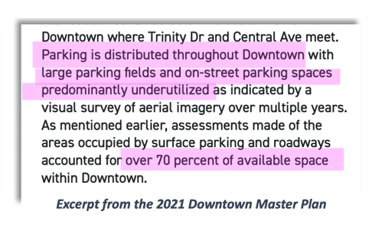 Assuming the answers to these questions are no, then the town needs County Council to approve two code changes that are critical to flipping that situation: one to ease limitations on building heights downtown and the other to reduce mandated parking requirements for new development. At its March 8 meeting, the Planning & Zoning Commission made a unanimous recommendation to County Council to update these two seemingly minor parts of our development code. The change could have big, positive implications for downtown redevelopment and the provision of badly-needed housing.
Assuming the answers to these questions are no, then the town needs County Council to approve two code changes that are critical to flipping that situation: one to ease limitations on building heights downtown and the other to reduce mandated parking requirements for new development. At its March 8 meeting, the Planning & Zoning Commission made a unanimous recommendation to County Council to update these two seemingly minor parts of our development code. The change could have big, positive implications for downtown redevelopment and the provision of badly-needed housing.
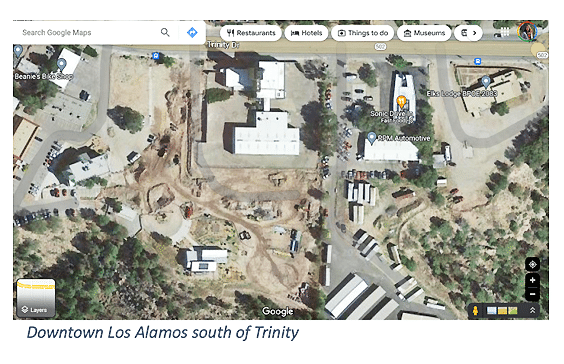 Council is slated to vote on P&Z’s recommendations at their Tuesday, May 2 meeting. If you are convinced by the arguments in this letter on building heights and the forthcoming companion piece on reduced parking mandates, I encourage you to reach out to Council to urge them to support these two code changes by accepting Planning & Zoning’s recommendations as worded. (I should note that although I am a member of the P&Z Commission, the opinions expressed here are mine alone.)
Council is slated to vote on P&Z’s recommendations at their Tuesday, May 2 meeting. If you are convinced by the arguments in this letter on building heights and the forthcoming companion piece on reduced parking mandates, I encourage you to reach out to Council to urge them to support these two code changes by accepting Planning & Zoning’s recommendations as worded. (I should note that although I am a member of the P&Z Commission, the opinions expressed here are mine alone.)
Here’s the background on why P&Z made those recommendations. Anyone can see from the number of abandoned buildings and empty parking lots that our downtown is hurting. While we face a number of factors outside our control when it comes to development (isolation, scarce land and labor, online shopping, expensive materials, etc.) there is one huge factor that is under our control as a town: our land-use codes. Our own 2021 Downtown Master Plan described LA’s development code as having “unclear and outdated … procedures that hinder development.” While Council did a lot with the 2022 Development Code update, they balked at the two changes that are arguably the most consequential.
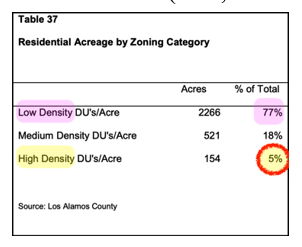 In spite of having very little developable land, Los Alamos has made it illegal on a large percentage of its residential land (77%, see image) to build anything other than land-intensive single-family homes. Most of America is this way, for reasons that are often unsavory. Here, this means retail businesses struggle, too because these rules have forced the town’s population to remain static instead of growing naturally to meet demand. If we could grow naturally, we’d have both customers and staff to help our small businesses thrive: daycares, dry cleaners, bakeries, appliance repairmen—if we want those, we need more people, and therefore more housing. The town also faces a dire shortage of essential workers like nurses, teachers, and firefighters, harming our kids, our health, and our safety.
In spite of having very little developable land, Los Alamos has made it illegal on a large percentage of its residential land (77%, see image) to build anything other than land-intensive single-family homes. Most of America is this way, for reasons that are often unsavory. Here, this means retail businesses struggle, too because these rules have forced the town’s population to remain static instead of growing naturally to meet demand. If we could grow naturally, we’d have both customers and staff to help our small businesses thrive: daycares, dry cleaners, bakeries, appliance repairmen—if we want those, we need more people, and therefore more housing. The town also faces a dire shortage of essential workers like nurses, teachers, and firefighters, harming our kids, our health, and our safety.
With only 5 percent of our scarce land available for high-density housing, we really need to make the most of it—and we simply can’t without allowing for taller buildings. A number of developers who were initially willing to invest in the town in spite of our isolation and our labor shortage have ultimately walked away from redevelopment projects. Why? Because of those onerous regulations on parking and building heights. When land is scarce, being able to add a few stories dramatically increases flexibility for builders, reduces costs, and increases retail and housing options. Adding to the height allowance doesn’t mean tall buildings will go up everywhere overnight, but it does mean that projects that might otherwise be prohibitively expensive now have a chance to avoid strangulation in the cradle. The initial development-code update on building heights accepted by P&Z at their Nov. 23, 2022 meeting allowed taller buildings across all of DTLA (official name for the downtown LA district), which was consistent with all of the town’s guiding policy documents.
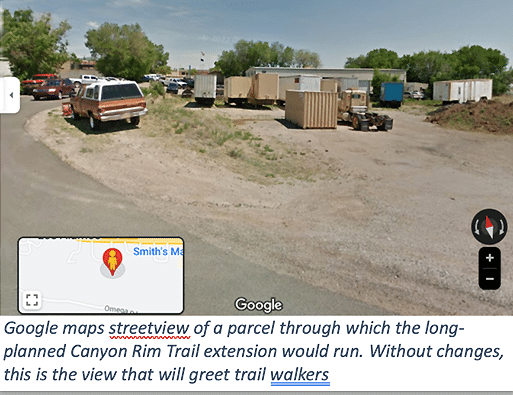 Then it was Council’s turn. They did not accept this recommendation. Toward the end of a long Council meeting on Nov 30, 2022, a motion passed to drastically reduce height limits for all of DTLA south of Trinity to a tiny 45-foot maximum: this change went the opposite direction of P&Z’s recommendation, making heights more restrictive than they had been historically, and cutting that tiny 5% patch where dense housing is allowed to almost nothing. At their Dec. 13 meeting, after hearing concerns about this, Council turned that proposal back over to P&Z for review and recommendation. P&Z’s decision on March 8 was unanimous (with one recusal): restore the original draft’s height limit for all of downtown, including south of Trinity, to 86′ — except within 150′ of Los Alamos Canyon, where the height limit would be stepped down to 54′. The stepdown was a compromise P&Z reached to allow for taller buildings while still protecting the canyon rim. P&Z concluded that there was minimal to no impact on viewsheds or recreation. Recreation options are preserved with a corridor for a future Canyon Rim Trail extension. (See the Canyon Rim Trail Master Plan for more information.)
Then it was Council’s turn. They did not accept this recommendation. Toward the end of a long Council meeting on Nov 30, 2022, a motion passed to drastically reduce height limits for all of DTLA south of Trinity to a tiny 45-foot maximum: this change went the opposite direction of P&Z’s recommendation, making heights more restrictive than they had been historically, and cutting that tiny 5% patch where dense housing is allowed to almost nothing. At their Dec. 13 meeting, after hearing concerns about this, Council turned that proposal back over to P&Z for review and recommendation. P&Z’s decision on March 8 was unanimous (with one recusal): restore the original draft’s height limit for all of downtown, including south of Trinity, to 86′ — except within 150′ of Los Alamos Canyon, where the height limit would be stepped down to 54′. The stepdown was a compromise P&Z reached to allow for taller buildings while still protecting the canyon rim. P&Z concluded that there was minimal to no impact on viewsheds or recreation. Recreation options are preserved with a corridor for a future Canyon Rim Trail extension. (See the Canyon Rim Trail Master Plan for more information.)
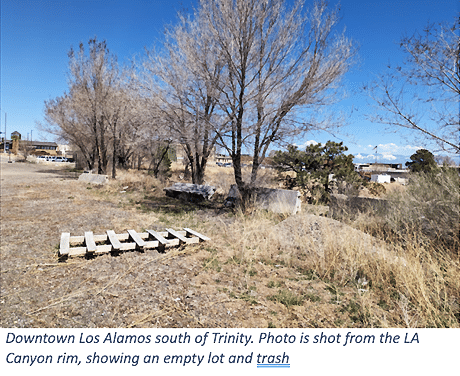 The main concern expressed by some County Councilors seemed to be that “building massing” near an eventual extension of the Canyon Rim Trail would be aesthetically unpleasing to trail users. Bear in mind the trail the previous Council seemed so worried about doesn’t even exist yet in the area under discussion: the Canyon Rim Trail stops at Smith’s, and it won’t extend westward until the county has negotiated easements from private-property owners that hold key sections of that rim land.
The main concern expressed by some County Councilors seemed to be that “building massing” near an eventual extension of the Canyon Rim Trail would be aesthetically unpleasing to trail users. Bear in mind the trail the previous Council seemed so worried about doesn’t even exist yet in the area under discussion: the Canyon Rim Trail stops at Smith’s, and it won’t extend westward until the county has negotiated easements from private-property owners that hold key sections of that rim land.
But let us assume the trail extension will exist. The Canyon Rim Trail, as its name suggests, is on the rim of Los Alamos Canyon, so nothing can come between trail-walkers and the beautiful canyon view to their south. To the north, there are no beautiful views: I encourage people to go look for themselves, with fresh eyes, at what exists south of Trinity.
The aesthetic concerns expressed by some Councilors might hold water if the current view were pleasing. It is not. Even if one were anti-buildings in general, it is hard to argue that new buildings could make this view any worse.
What might replace empty lots and blight? Could be retail, could be multifamily housing—hopefully both, with retail on the bottom floor and housing on the upper floors, the way most dense, walkable cities do it. The DTLA and WRTC (White Rock Town Center) overlay districts encourage mixed retail and housing, which fulfills the Comprehensive Plan and Downtown Master Plan’s emphatic directive to increase the town’s housing supply. As the latter plan states, “Increasing the allowed maximum residential densities and building heights is one of the main tools to increase the provision of housing in Los Alamos County and make housing more affordable.” (emphases mine)
 How we move forward is now in the hands of County Council. I write this letter because I am nervous about what Council is going to do on May 2. As Commissioner Ben Hill put it at the March 8 P&Z meeting, the Council has seemed more concerned about aesthetics than in filling its promise of encouraging more housing. “It’s as if architecture were bad,” he said. “It’s like, ‘Oh my gosh, there’s a building there, let’s push it away and make it smaller.’” Hill added that he’s “been in cities that have beautiful river walks that are similar to the Canyon Rim Trail, and they have buildings and restaurants pushed right up against there. It does make it an enlivened experience: something this town really needs.”
How we move forward is now in the hands of County Council. I write this letter because I am nervous about what Council is going to do on May 2. As Commissioner Ben Hill put it at the March 8 P&Z meeting, the Council has seemed more concerned about aesthetics than in filling its promise of encouraging more housing. “It’s as if architecture were bad,” he said. “It’s like, ‘Oh my gosh, there’s a building there, let’s push it away and make it smaller.’” Hill added that he’s “been in cities that have beautiful river walks that are similar to the Canyon Rim Trail, and they have buildings and restaurants pushed right up against there. It does make it an enlivened experience: something this town really needs.”
Moreover, tallish buildings south of Trinity would offer fantastic views of LA Canyon. As the canyon is off-limits for hiking, it can only be seen from the rim, so buildings near the rim would elevate and multiply views. There are currently no amenities on  the canyon rim in the DTLA district, no paths or viewpoints aside from the patio at Smith’s, and the tiny section of the Canyon Rim Trail between the patio and the canyon. I believe most people would agree that the Smith’s patio to the north of the trail does nothing to upset their views of the canyon to the south.
the canyon rim in the DTLA district, no paths or viewpoints aside from the patio at Smith’s, and the tiny section of the Canyon Rim Trail between the patio and the canyon. I believe most people would agree that the Smith’s patio to the north of the trail does nothing to upset their views of the canyon to the south.
I think the County Council, when they initially voted to remove building-height flexibility for DTLA south of Trinity, had their hearts in the right place: they were trying to protect a potential recreation resource. As a former chair of the Parks & Recreation Board who was (and is) passionate about protecting our town’s vital open space, I understand where Council was coming from. However, as I hope I’ve demonstrated, these concerns are unfounded. The status-quo situation is not one of “beautiful views.” The area between Trinity and the rim of Los Alamos Canyon suffers from decades of blight and neglect. Smart investment will bring economic, housing, and recreational opportunities to an area that currently has none of those.
A final, essential point I want to make is that the 2021 Downtown Master Plan states that two keys to seeing our town’s vision come to fruition are very specifically allowing greater flexibility over parking and building heights. While individuals may have their opinions, these plans were brought about through a long and democratic process and reflect the town’s wishes writ large. The Planning and Zoning Commission has listened and responded, but on these key provisions, previous Councils have balked at every turn. Now it’s a new Council, with another chance to get it right.
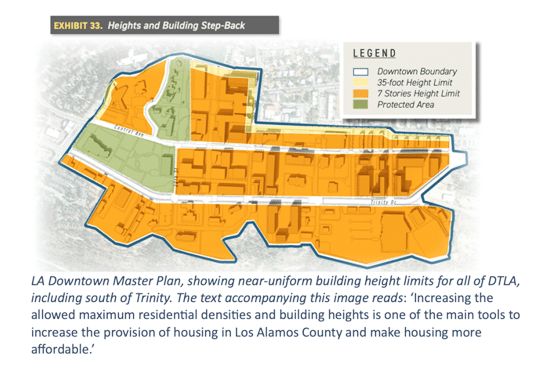 Los Alamos has clear policies in place that name housing as a top priority. We’re pretty much at the mercy of Council to turn policies into reality. Therefore, I urge them to accept P&Z’s unanimous recommendation to allow builders the option of taller buildings south of Trinity. Los Alamos needs this kind of zoning flexibility to attract developers to invest in downtown south of Trinity—a large section of downtown that desperately needs some love and care. If you agree, please show up to the May 2 meeting, and/or email the Los Alamos County Council (countycouncil@lacnm.us) to urge them to accept Planning & Zoning’s recommendation as worded.
Los Alamos has clear policies in place that name housing as a top priority. We’re pretty much at the mercy of Council to turn policies into reality. Therefore, I urge them to accept P&Z’s unanimous recommendation to allow builders the option of taller buildings south of Trinity. Los Alamos needs this kind of zoning flexibility to attract developers to invest in downtown south of Trinity—a large section of downtown that desperately needs some love and care. If you agree, please show up to the May 2 meeting, and/or email the Los Alamos County Council (countycouncil@lacnm.us) to urge them to accept Planning & Zoning’s recommendation as worded.
For more on the parking-mandate side of the equation, stay tuned, I will write a separate letter on that topic.

